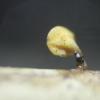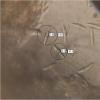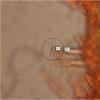
31-12-2025 19:27
Collected from loamy soil, at waterside (completel

30-12-2025 16:44
Pascal DucosBonjour,Une anamorphe rose stipitée, très nombre

30-12-2025 17:14
 Bernard CLESSE
Bernard CLESSE
Bonjour à toutes et tous,Pourriez-vous aider Albe

29-12-2025 10:15
Hulda Caroline HolteHello, I found and collected this propoloid ascom

30-12-2025 09:04
Hello.A Pyrenomycete sprouting sparsely but very d

29-12-2025 17:44
Isabelle CharissouBonjour,J'aimerais savoir si d'autres personnes au

12-11-2021 00:03
Lepista ZacariasHi everybody,A week ago in my fiels trip I noticed
Hymenoscyphus ... possibly epiphyllus?
Alan Smith,
17-10-2017 22:55
Merci d'avance, Alan
Hans-Otto Baral,
18-10-2017 07:52

Re : Hymenoscyphus ... possibly epiphyllus?
Hi Alan
This is clearly Hymenoscyphus menthae (= H. consobrinus). You may consult my paper on this:
Hymenoscyphus menthae, H. macroguttatus and H. scutula, a
comparative taxonomic study emphasizing the value of spore
guttulation and croziers. Ascomycete.org, 7 (6) : 255-287. (2015)
Typical are the navicular multiguttulate, homopolar spores without a perceptible upper end.
This is a plurivorous species, like H. epiphyllus which differs in a consistently short stout stipe, and spores with large and small drops, also in having croziers at the ascus base.
Urtica and Rubus are very easily separated in a cross section. Urtica 4-angled with cavities in the xylem.
Zotto
This is clearly Hymenoscyphus menthae (= H. consobrinus). You may consult my paper on this:
Hymenoscyphus menthae, H. macroguttatus and H. scutula, a
comparative taxonomic study emphasizing the value of spore
guttulation and croziers. Ascomycete.org, 7 (6) : 255-287. (2015)
Typical are the navicular multiguttulate, homopolar spores without a perceptible upper end.
This is a plurivorous species, like H. epiphyllus which differs in a consistently short stout stipe, and spores with large and small drops, also in having croziers at the ascus base.
Urtica and Rubus are very easily separated in a cross section. Urtica 4-angled with cavities in the xylem.
Zotto
Alan Smith,
18-10-2017 16:19
Re : Hymenoscyphus ... possibly epiphyllus?
das ist sehr hilfreich, Zotto, danke







